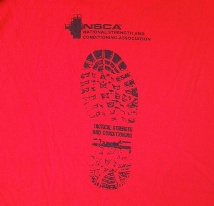
By Michael Krueger
From April 16-18, I attended the National Strength and Conditioning Associations (NSCA) Tactical Strength and Conditioning conference in Norfolk, Virginia. This conference was a little different than the average NSCA event in that rather than dealing with individual athletes, teams, or the just the average person, it focused on the unique strength, conditioning, injury prevention, and wellness needs of firefighters, police agencies, and the military. The following is some of what I learned.
Firefighter State of the Union
The first session was a wide- ranging discussion covering everything from fitness standards to injury and rehab to operational performance. The bottom line was that while everyone agreed that there was plenty of room for improvement, there were many different ways to get whereever someone thought we ought to go, wherever that might be.
It was agreed that the fire service is in need of fitness standards, but what they should be and how they should be determined was cause of much debate. Should there be different standards for volunteers and paid? What about the different demands between urban and rural or even smoke jumpers? There were discussions regarding programs that focused on health vs. injury prevention vs. performance; were they separate issues or were they all part of a comprehensive progressive program?
The question of on- duty workouts and the problem of residual fatigue were discussed. It has been found that firefighters who worked out on duty were likely to see a slight decline in performance when required to respond to a call either during or shortly after their exercise period. On the other hand, they were still responding at a considerably higher level than firefighters who didn’t work out at all.
Injuries sustained during exercise have skyrocketed when compared with injuries on active calls, but then the definition of what qualified as exercise was questioned. Did participation in competitive sports count as exercise? When basketball, soccer, football, and CrossFit injuries were taken out of the equation, exercise injuries weren’t a major factor. If a firefighter worked out regularly, he was twice as likely overall to report an injury but only half as likely to be injured on the fireground.
At one Canadian department, compliance with in-house fitness training and testing approaches 90 percent, yet injury rates didn’t go down as much as expected. The members think that they may be training too much for performance and not enough for injury prevention. They are trying to balance creating a fit high-performing population with fostering an injury-free population by stressing proper movement patterns and core strength.
The testing, evaluation, and training of cadets in relation to incumbent firefighters spurred a rather lively exchange. The proposal that veterans should be held to the same standards as recruits was brought up, and a fair number of people weren’t thrilled with the possibility. The arguments against tended to rely on personal freedom, while the arguments for tended toward personal responsibilities.
There was a discussion on the perceived lowering of CPAT standards to promote diversity. It was opined that the CPAT should only be considered the absolute minimum and that after passing it a firefighter should then continue to progress to being an efficient and proficient firefighter, perhaps even rising to nationally recognized ranks as one progresses. If a firefighter has to train a lot just to pass the CPAT, he has a long way to go toward the goal of proficiency. What should the path to the highest level look like regarding training and testing; should it be mandatory and should it include the upper echelons of the department?
Europe and Canada tend to focus more on performance, while the United States focuses more on health issues (don’t confuse health issues with injury prevention, since the United States has more injuries than Canada or Europe. The question then had to be asked, is this because firefighters in the United States are inherently less healthy because of questionable nutrition and lack of physical activities outside of fire specific training and therefore require more intensive medical and pharmacological interventions to deal with chronic (i.e., preventable) health problems? No one had an answer for that, but it did make some folks uncomfortable, which is probably a good thing.
The fact that testing can only take one so far since by its very nature it is only a simulation and therefore is of only limited use created a lot of discussion. Statistically, we can reduce risk by having fitter and better trained personnel, but we certainly can’t eliminate risk. Then to complicate it even more, by implementing additional and more intense training, both fitness and operational, we will in some circumstances create more risk and therefore additional injuries.
Every session I attended, no matter what the primary subject, always ended with a discussion revolving around cost/benefit and politics. The questions of (1) who pays for the programs and equipment and (2) are they worth the investment were frequently brought up. One person anecdotally related that when workers’ compensation costs declined after the implementation of a fitness program, city administrators, while glad that those costs declined, complained about the cost of the program. When the savings in workers’ comp was mentioned, they responded that “you can’t prove those costs wouldn’t have declined on their own without the added expense of the fitness program”; then they reduced the funding for the fitness program.
Other huge concerns were who administers any testing and could a negative result affect employment status. Then the union reps asked whether changes could be made unilaterally without renegotiating a new contract. Can anyone really be forced to exercise? All good concerns, and there were as many answers (and nonanswers) as there were speakers.
What this roundtable discussion showed was that even people who are well meaning and focused on fitness have varying agendas. People tended to talk at each other rather than to each other, and there are a lot more questions than answers. On the other hand, people were respectfully discussing these and many more very important topics.
Evening Debates
There were many interesting sessions during the day, but the real conversations took place in the lobby, elevators, cafes, bars, and restaurants in the evening. The exchanges were wide-ranging and, at times, a bit heated. The areas that caused the most conflict were cost/benefit of fitness programs and the ever-present specter of mandatory fitness training for all members of the fire service.
First, you need to remember that most of the personnel who attend a conference such as this one are already interested in fitness and keep themselves in reasonable good condition. They firmly believe that all firefighters should maintain themselves in optimal physical condition. Second, the vast majority of the firefighters were union members and fiercely loyal to their firefighter brethren; therefore, they didn’t like decisions being made that could affect anyone’s continued employment. Some people admitted that this dichotomy put them in a very uncomfortable place when it came to mandatory fitness training and standards. Just a side note: I sat in on some of the law enforcement sessions, and those attendees were even more hostile to testing and mandatory standards and, based on my cursory observations of their outward fitness levels, needed them even more.
Talking with firefighters from all over the country was interesting, to say the least. They all fiercely defended the fitness and readiness of their own department while also admitting that less than one-third of their personnel were active in a formal exercise program or in satisfactory, much less optimal condition. I think they had some trouble wrapping their heads around this contradiction, but loyalty to your department is important (as is discretion), so no one pointed it out.
Overall Impression
I was impressed by the great many firefighters who are dedicated and committed to improving the health, fitness, and well-being of members of the fire service. These people put in a lot of time and effort, much of it off-duty and without pay, in an effort to make their dream of a highly functioning, healthy, and fit fire service a reality.
Something that was obvious was that these men and women had committed themselves to personally being the best firefighters, citizens, and friends they can be. These people lead by example in the hopes that others will follow. Thus far, they have had only limited success, but they are completely undaunted. They continue to lobby their local elected officials for additional resources and their union leaders and fellow firefighters for support.
Sometimes they are successful and sometimes they are not, but they will no doubt keep on trying since, as one speaker said, “…it’s literally a matter of life and death.”
Michael Krueger is an NSCA-certified personal trainer. He got his start in fitness training while serving in the United States Coast Guard. He works with firefighters and others in and around Madison, Wisconsin. He is available to fire departments, civic organizations, and athletic teams for training, consulting, and speaking engagements. He has published numerous articles on fitness, health, and the mind-body connection and was a featured speaker at the IAFC’s FRI 2009 Health Day in Dallas, Texas. E-mail him at MKPTLLC@gmail.com.


